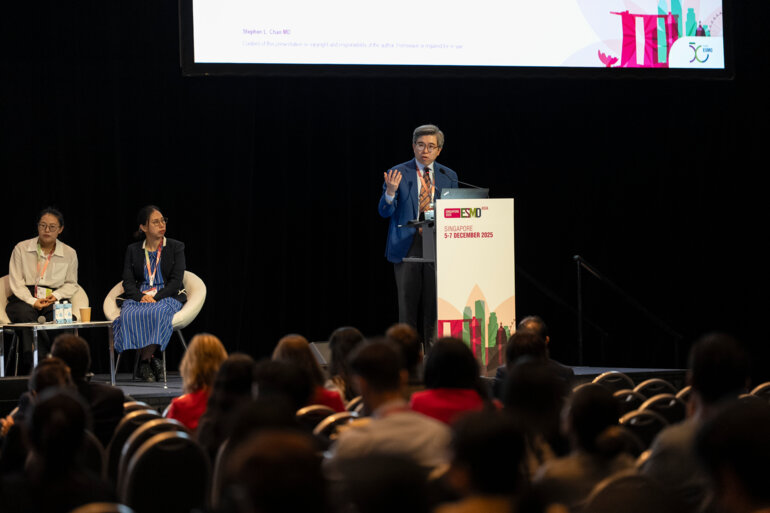Early studies investigated the potential of genomic profiling, but prospective and comprehensive data are required to support wider implementation
Advances in genomic profiling and targeted therapies offer the potential for more personalised treatment strategies and improved clinical outcomes for all types of cancer, including rare malignancies. Two studies presented during a Mini Oral Session at the ESMO Congress 2025 (Berlin, 17–21 October) highlight the potential utility of such approach which, however, comes with associated challenges.
The preliminary findings of the IMPRESS-Norway trial, a prospective study that offered genomic profiling and alteration-matched targeted therapies to patients with advanced cancers who had exhausted standard treatment options, provide important insights. Among 158 treated patients evaluable for efficacy at 16 weeks, 1% had a complete response, 19% had a partial response, 25% had stable disease and 46% had progressive disease, resulting in a 16-week disease control rate of 46% (Abstract 114MO). However, more granular data will be required to fully understand the benefits for individual patients. Notably, ovarian cancer was among the most frequent malignancy in the IMPRESS-Norway cohort, representing 14% of treated patients. Given the diversity of ovarian cancer subtypes, a subtype-specific breakdown is needed to identify which patients meet the criteria for rare cancers and to interpret outcomes appropriately.
Ovarian cancer provides an illustrative example of how definitions of rare cancers vary internationally. These classifications should be approached with openness, acknowledging a continuum that ranges from ultra-rare cancers to more common malignancies. With an age-standardised annual incidence rate of 6.7 new cases per 100,000 women in 2022 (Int J Cancer. 2025;156:1336–1346), ovarian cancer meets the U.S. definition of a rare cancer (<15 per 100,000) but does not fit the European threshold (≤5 per 100,000). This discrepancy underscores the lack of consensus in defining rarity across regions.
Moreover, ovarian cancer exemplifies a tumour type in which numerous randomised clinical trials have been conducted to refine state-of-the-art treatment strategies. This highlights that, even in the context of rare cancers, randomised trials remain both doable and of value. Whole-exome and whole-genome sequencing, whole transcriptome sequencing and multispectral immunofluorescence profiling were used to unveil distinct molecular and expression-based subsets, as well as key tumour-intrinsic and microenvironmental features in the Rare Tumor Initiative at MD Anderson Cancer Center, which molecularly profiled >1,100 patients with >150 rare cancer types and subtypes (Abstract 113MO).
Both studies presented at the ESMO Congress highlight that determining the extent to which molecular data and matched therapies translate into tangible patient benefit remains a substantial challenge. The first issue lies in distinguishing treatment effects across different lines of therapy from the natural course of disease. In other words, a patient presenting with stable disease – as was the case for 30% of patients in the IMPRESS-Norway trial – may do so for two reasons: either the therapy is truly slowing tumour growth, or the cancer biology itself is relatively indolent.
In order to distinguish between those two different scenarios, tools such as tumour growth kinetics or calculation of the ratio of time to progression on a new therapy versus the most recent prior therapy can provide data specifically on the benefits of each line of treatment (J Clin Oncol. 2012;30(Suppl 15):10013; Ann Oncol. 2019;30(Suppl 5):485P). Evaluating outcomes in the context of responses to previous therapies – for instance, by using the ratio of progression-free survival under the novel therapy to that under the preceding one, as defined by the Von Hoff criteria – is particularly relevant when patients receive multiple sequential treatments, as it helps to better assess the true therapeutic value of the new intervention (J Clin Oncol. 2010;28:4877–4883; Eur J Cancer. 2021;159:56–59).
A second challenge we face as a community is collecting comprehensive data sets using a systematic and prospective methodology, particularly in settings where off-label treatments are guided by molecular profiling. In that regard, both studies illustrate this is feasible and pave the way for, I hope, broader similar efforts.
In many countries, off-label targeted therapies are offered to patients without systematic data collection, representing a missed opportunity. Both positive and negative outcomes are informative: while favourable responses can validate therapeutic approaches, non-responders provide equally valuable insights for guiding future strategies. Early identification of whether a therapy is likely to be ineffective can optimise resource allocation, avoid unnecessary toxicity, and facilitate timely enrolment of patients in clinical trials.
Finally, access to genomic profiling remains a key challenge, with many countries lacking the financial and logistical resources needed to both perform the tests and to interpret the results. Another major factor is the availability of targeted therapies. Even if profiling is available, the clinical utility will be limited if countries do not have access to the corresponding therapies. Generating a robust evidence base through coordinated, prospective data collection will be critical, not only to guide clinical decision-making but also to build a case for broader access to precision medicine approaches. Only with such data can the potential of genomic profiling in rare cancers be fully realised and translated into meaningful improvements in patient outcomes.
Programme details
Puco K, et al. Clinical benefit of genomic-guided targeted therapies in patients with rare cancers: First results from the IMPRESS-Norway trial. ESMO Congress 2025 - Abstract 114MO
Woodman S, et al. Multimodal molecular investigation of >1,000 rare cancer patients (pts) reveals key tumor states and germline susceptibility genetics. ESMO Congress 2025 - Abstract 113MO







